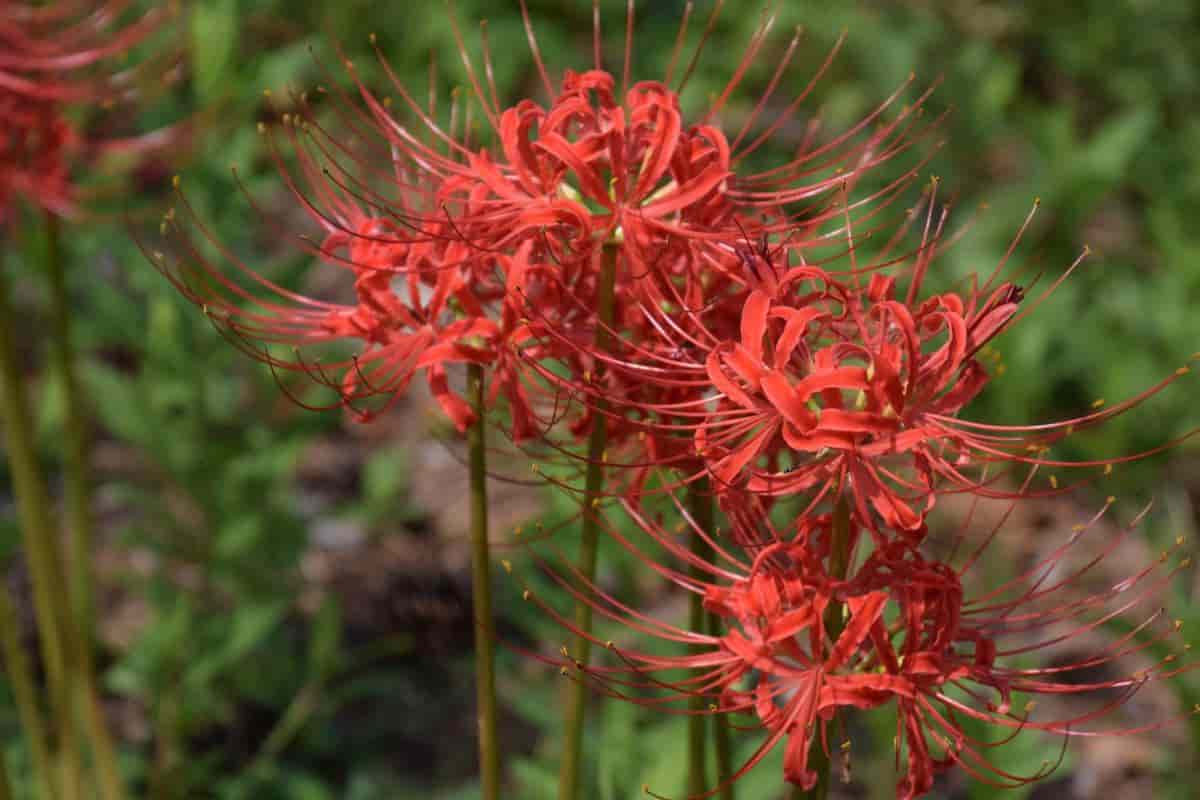Red spider lilies (Lycoris radiata) raise their red umbrellas in the flower borders of the middle south during drought-stricken September, bringing the only vivid coloring to a parched land.
The umbrella handle is a 2-foot tall scape, bearing an umbel 6/2” inches wide, of 5 to 7 red trumpet-shaped flowers.

The perianth segments or “petals” are crisp and recurved, and the flowers have showy filaments and anthers from which they have acquired their common name.
Origin Of The Garden Bulbs
Long ago, when the port of Japan was opened by Commodore Perry, Captain William Roberts of Bern, North Carolina, brought to his home garden bulbs of Lycoris radiata.
As the years passed, the origin of the bulbs was forgotten, and as the flowers resembled those of Nerine sarniensis they were called nerines.
About 15 years ago, some botanists found that the seeds of Lycoris radiata were black and not green like those of nerine, and the bulb flowers were properly identified.
Importing Red Spider Lilies
Red spider lilies have been grown commercially in this country for many years to supply the domestic market.
However, since the war and imports from Japan have resumed, bulbs of L. radiata are being shipped here yearly from Japan and include perhaps new varieties and at least one rare species.
Recently, a Lycoris radiata alba has been imported from Japan. Still, it does not answer the accepted description of L. radiata alba, which is said to be cream-colored when opening and turning white with age.
The rare L. straminea species has straw-colored segments with pink keels and scattered red dots.
Phis lycoris has wider leaves than radiata, and flowers on September 1, two weeks earlier than L. radiata.
Among the new lycoris arrivals from Japan is a larger and better gold-colored Lycoris aurea than is grown in Florida. It is the last lycoris to bloom, flowering on September 25.
Tender Amaryllis
All lycoris, except L. squamigera (Surprise Lily) or hardy amaryllis, are rated tender.
There is nothing tender about L. radiata in the Tulsa area, as it stands winter cold without mulching or other protection.
Lycoris aurea (the Asiatic import) survives Tulsa’s winters, and so does L. straminea.
Lycoris radiata, straminea, and aurea, aside from their excellent garden value in the way of beauty, are remarkable for their adaptation to either a sunny or shady situation, to drouth or ample moisture, and their indifference to the soil.
Shallow Planting The Bulbs
Plant the bulbs when available commercially, usually during July and August. Homegrown bulbs are lifted as soon as their foliage disappears, usually mid-May.
Shallow planting is a “must,” as bulbs planted deeper than one inch of soil over their tops will not flower.
After flowering during September, the bulb foliage appears and stays through the winter into May.
Lycoris aurea foliage winter kills here during late January or early February but can store enough carbohydrates for its needs, as it flowers despite cold weather.
Companion Plants
As lycoris produces no foliage at the blooming time, it is best to plant the bulbs among columbines or the hardy orchid (Bletilla striata) to give the red, pink-striped, or golden umbrellas a green setting.
A succession of blooms can be had by planting L. radiata both in sun and shade as when grown in shade it flowers two weeks earlier than in sun.
Lycoris straminea (alba) flowers on September 1, followed by L. radiata in mid-September and L. aurea a little later.
The lycoris genus has only one fault: it flowers when it pleases. For that reason, one should plant at least a dozen bulbs of a species so that there will be some flowers each year.
Lycoris Idiosyncrasy
As far as can be ascertained, there seems to be no established reason for this lycoris idiosyncrasy.
In the case of Lycoris aurea, which is more reluctant than the others to flower, there may be enough cold to kill the bud but not the bulb.
One finds similar behavior in Hymenocallis calathina, which, although perfectly hardy, must be stored at a warm indoor temperature during winter.
However, in the case of Lycoris radiata and straminea, it may be that planting the bulbs close to their flowering time prevents blooming.
If lycoris bulbs are dug any time during summer, they will be found to have no roots and will be as thoroughly dormant as tulip bulbs.
Plant Large Bulbs
As for Lycoris squamigera (the hardy one), the lack of success with it is probably due to small bulbs being planted instead of large ones.
Shallow planting seems to be necessary. Instances of non-blooming bulbs have been traced to their being planted with 6” inches of soil over their tops.
One inch of covering suffices for the Tulsa area, probably 2” or 3” inches sufficient for Kansas City and St. Louis.
Lycoris squamigera, which resembles an amaryllis more than a spider lily, usually begins flowering in Tulsa by July 26 but puts off its arrival until August some seasons. It bears large, fragrant, rose-lilac flowers on a two-foot high scape.
Lycoris For Arrangements
As it is sometimes known as “naked lady,” arrangements should be made to have it suitably surrounded with foot-high plants to give it the proper setting. In our vicinity, it grows well in partial shade.
As the lycoris “umbrella” type has not been given much testing north of zone 6, it would be good for garden clubs to try out some of the so-called tender species to see if they will withstand mid-American conditions.
Lycoris flowers are not only decorative in the garden but are of high value for flower arrangements and corsage making.
No flower, unless it is an orchid, has the keeping qualities of Lycoris radiata and its similar species.
44659 by Lula Egan Quinlan
